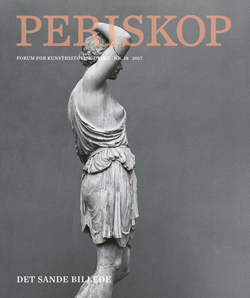Fuldskalamodellen. Arkitekturens sande billede mellem realitet og forestilling
DOI:
https://doi.org/10.7146/periskop.v15i18.105151Resumé
The Full-Scale Model. Architecture’s True Image Between Reality and
Imagination
The paper examines the full-scale architectural model and the question of the truthful image. This question, concerning the representation and its reliability, is continuously present in architecture: to what extent does the architectural image – and we may regard the architectural model as such – provide us with a truthful image of a future project? Architects rely on various types of representations in order to provide an image of a reality yet to come: the realised building. Reality and the image of the possible are fully entangled in the architectural model, in particular in the full-scale model where differences of scale are eliminated. Through a discussion of the virtual and actual aspects of the full-scale model, the paper concludes that the model provides insight into future realities and as such can be regarded as a truthful image, but that it furthermore – due to the ambiguous proximity of the virtual and actual – exposes the question of truth as being contingent on a relation between reality and fiction. The paper is based on analysis of selected empirical cases, including a mock-up of Sverre Fehn’s project for an extension of the Royal Danish Theatre (1996), Robbrecht en Daem architecten’s Mies 1:1. Das Golfklub Projekt (2013), the full-scale model of Ludwig Mies van der Rohe’s proposal for the Kröller-Müller villa (1912), Bungalow Germania – the German pavilion at the Venice Architecture Biennale (2014) and the simulation of the Berlin Castle (1993-94).
Downloads
Publiceret
Citation/Eksport
Nummer
Sektion
Licens
Copyright (c) 2018 Forfatteren og Periskop

Dette værk er under følgende licens Creative Commons Navngivelse (by).
Forfattere, der publicerer deres værker via dette tidsskrift, accepterer følgende vilkår:
- Forfattere bevarer deres ophavsret og giver tidsskriftet ret til første publicering, samtidigt med at værket 12 måneder efter publiceringen er omfattet af en Creative Commons Attribution-licens, der giver andre ret til at dele værket med en anerkendelse af værkets forfatter og første publicering i nærværende tidsskrift.
- Forfattere kan indgå flere separate kontraktlige aftaler om ikke-eksklusiv distribution af tidsskriftets publicerede version af værket (f.eks. sende det til et institutionslager eller udgive det i en bog), med en anerkendelse af værkets første publicering i nærværende tidsskrift.
- Forfattere har ret til og opfordres til at publicere deres værker online (f.eks. i institutionslagre eller på deres websted) forud for og under manuskriptprocessen, da dette kan føre til produktive udvekslinger, samt tidligere og større citater fra publicerede værker (se The Effect of Open Access).


